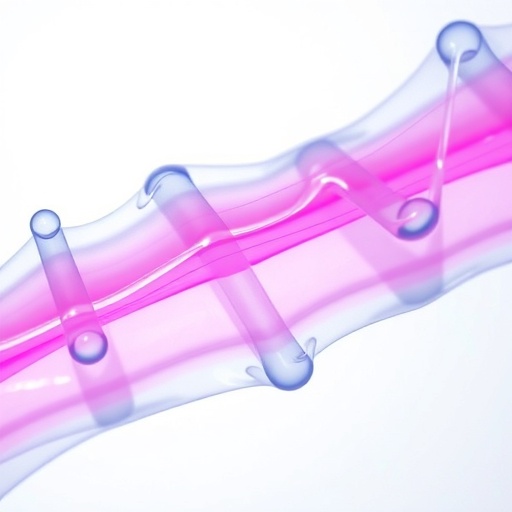In the rapidly evolving field of tissue engineering, recent advances have propelled the development of biomaterials that closely mimic the complex mechanical characteristics of native tissues. A groundbreaking study led by Zhu, Wang, Yang, and colleagues has unveiled a novel class of high-strength mechanically gradient hydrogels created through physical crosslinking strategies. These hydrogels, designed explicitly for tendon-mimetic tissue repair, promise a transformative shift in regenerative medicine and flexible electronics, bridging the gap between synthetic materials and biological function with unprecedented precision.
Tendons are essential connective tissues that transmit forces between muscle and bone, enabling movement and stability. Their unique structural characteristics feature a gradient of mechanical properties, transitioning from soft, compliant muscle attachments to stiff, durable bone insertions. Replicating this mechanical gradient within synthetic hydrogels has long been a challenge due to the intrinsic limitations of uniform polymer networks, which often fail to balance strength, elasticity, and biocompatibility simultaneously. Zhu and colleagues tackled this problem head-on by engineering hydrogels that regenerate this gradation through controlled physical crosslinking methods, circumventing traditional chemical crosslinkers that might compromise biological compatibility.
At the core of this innovation is a physical crosslinking technique that manipulates polymer chain interactions without introducing covalent bonds, thereby preserving reversibility, self-healing capability, and dynamic responsiveness under physiological conditions. The team employed a meticulous assembly of polymer components whose interactions are fine-tuned to generate regions with distinct mechanical stiffness. This gradient structure emulates the natural transition in tendon tissues, improving cellular integration and mechanical performance under dynamic loading situations, pivotal for functional tissue regeneration.
In practical terms, the hydrogel’s strength arises from dual physical crosslinking domains that include hydrogen bonding and hydrophobic association. These non-covalent interactions provide a balance of stability and flexibility, allowing the material to withstand substantial mechanical stress while maintaining elasticity. Zhu et al. demonstrated that the physical crosslinks serve as sacrificial bonds, dissipating energy efficiently during deformation, a property crucial for mimicking the fatigue resistance of tendons subjected to repetitive strain cycles.
Moreover, the formation of a mechanical gradient within the hydrogel matrix is orchestrated by spatially controlling the crosslinking density. This gradient not only augments the toughness and strength of the material but also guides cell migration and differentiation within the scaffold. Tendon cells, or tenocytes, are notoriously sensitive to mechanical cues, and this engineered substrate supplies a biomimetic environment that enhances their alignment and proliferation, thereby accelerating the healing process in tendon injuries.
The implications of this research extend beyond tendon repair. By advancing the methodology of physical crosslinking to create tunable mechanical gradients, the study opens avenues for designing hydrogels tailored to other complex tissues that exhibit heterogeneous structures, such as cartilage, ligaments, and even interfaces in flexible electronic systems. The dynamic nature of the physical bonds allows these hydrogels to interface seamlessly with biological systems, potentially serving as bioelectronic platforms where mechanical compliance and electrical function coexist.
From a materials science perspective, the research stands out by leveraging supramolecular chemistry principles to impart both structure and function. The reversible interactions offer self-healing properties that conventional hydrogels lack, granting longevity and durability in physiological environments. Experimental data showcased by the team confirms remarkable recovery of mechanical properties post-damage, suggesting that such hydrogels could enhance implant lifespan and reduce the frequency of surgical interventions.
The team’s methodological approach involved synthesizing a copolymer system integrated with moieties capable of hydrogen bonding and hydrophobic interactions, carefully calibrating monomer ratios to dictate mechanical outputs. Mechanical testing revealed elastic moduli spanning across the physiological range of natural tendons, alongside impressive tensile strength, surpassing many previously reported hydrogel systems. Additionally, cyclic loading experiments demonstrated outstanding resilience and negligible hysteresis, indicative of the effective energy dissipation mechanisms facilitated by physical crosslinks.
Biocompatibility assays conducted in vitro confirmed that the hydrogel environment supports tenocyte viability and does not elicit adverse inflammatory responses. Cell culture studies further revealed organized extracellular matrix deposition, a hallmark of functional tendon regeneration. These findings underscore the potential of mechanically gradient hydrogels as scaffolds that not only restore physical continuity but actively participate in tissue remodeling and repair.
Critically, the absence of permanent chemical crosslinkers reduces cytotoxic risks and simplifies fabrication, offering an accessible platform for clinical translation. The use of physical crosslinking also allows for facile tuning of mechanical gradients by modulating environmental stimuli such as temperature or ionic strength, which could enable personalized therapeutic designs matching patient-specific tissue mechanics.
This study represents a significant stride in biomaterials innovation where mechanical competence meets biological activity. The team’s results, published in the highly respected journal npj Flexible Electronics, set a new benchmark for hydrogel design targeted toward soft tissue repair, particularly for challenging anisotropic tissues like tendons. By addressing both the mechanical and biological aspects simultaneously, these hydrogels manifest the ideal scaffold that has eluded researchers for years in regenerative medicine.
Future directions envisioned by Zhu and colleagues involve integrating electrical conductivity into these mechanically gradient hydrogels, thereby coupling biomechanical and electrophysiological functionalities. This synergy is especially relevant in bioelectronic medicine, where flexible platforms capable of biomechanical support and electrical signaling could revolutionize treatments for musculoskeletal disorders and neural interfacing.
In conclusion, the development of high-strength, mechanically gradient hydrogels via physical crosslinking constitutes a versatile and impactful innovation for tissue repair, holding promise to significantly improve clinical outcomes for tendon injuries. This work offers an inspiring blueprint for the field of flexible biomaterials, illustrating how careful manipulation of polymer physics can bridge synthetic constructs with natural tissue mechanics, paving the way for next-generation medical therapies and smart implantable devices.
Subject of Research: High-strength mechanically gradient hydrogels designed via physical crosslinking for tendon-mimetic tissue repair.
Article Title: High-strength mechanically gradient hydrogels via physical crosslinking for tendon-mimetic tissue repair.
Article References:
Zhu, H., Wang, C., Yang, Y. et al. High-strength mechanically gradient hydrogels via physical crosslinking for tendon-mimetic tissue repair. npj Flex Electron 9, 53 (2025). https://doi.org/10.1038/s41528-025-00430-7
Image Credits: AI Generated




